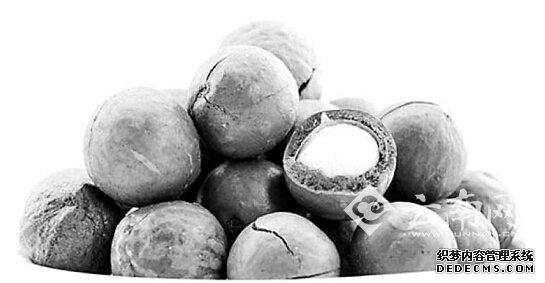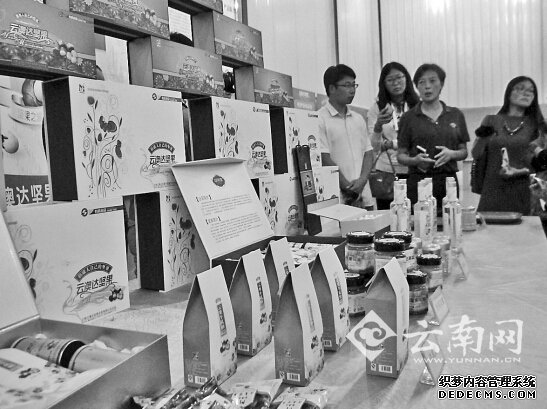Yunnan Province has planted 1.6 million mu of macadamia nuts with the largest acreage in the world.


Thirty-five years ago, the Tropical crop Science Research Institute of Yunnan Province introduced macadamia nuts for trial planting. Who would have thought that now Yunnan Province has planted more than 1.6 million mu of macadamia nuts, not only more than other provinces, but also more than any other country in the world. Macadamia nuts have also led farmers to increase their income by interplanting with other crops, with a yield of up to 10,000 yuan per mu.
The planting area of macadamia nut introduced for 35 years is more than 1.6 million mu.
On the 15th, the third interview team of the "Cloud Brand Story" series to promote agricultural products with plateau characteristics came to Lincang to visit the cultivation of macadamia nuts and participated in the provincial macadamia nut industry promotion meeting on the 16th.
Macadamia nut, also known as Hawaiian fruit, is a mountain dragon eye tree fruit tree, is recognized in the world as a valuable edible dried fruit and woody oil. Its kernel fat content is more than 78%, of which unsaturated fatty acids account for 84%. The fruit oil is fragrant and delicious and is a kind of high-grade edible oil. Native to Australia, it was introduced to other places in 1850.
China began to introduce and trial planting in the 1980s. Because its main root system is underdeveloped and afraid of strong winds, it is very suitable for planting in Yunnan. It was first planted in Yunnan Province in 1981 and was introduced and tested by Yunnan Tropical crop Science Research Institute.
Liu Yidan, party member and deputy director of the Provincial Forestry Department, said that up to now, the planting area of macadamia nuts in the province has reached more than 1.6 million mu, of which Zhenkang, Yingjiang and other five counties have planted more than 100000 mu. It is planned that by 2020, the area of macadamia nut forest in the province will develop and stabilize at 4 million mu. Therefore, despite the fact that its name is very foreign, in fact, the vast majority of what citizens eat are Yunnan ethnic groups.
Benefit planting macadamia nut benefit good interplanting coffee yield ten thousand yuan per mu
People can't help asking why macadamia nuts have such a large planting area in Yunnan in a short period of 35 years, and what attracts farmers and enterprises to plant and process them.
Lu Biao, a villager from Xiamancun Village, Happiness Town, Yun County, Lincang City, said that his family used to grow sugar cane and corn, but the output value was very low. In 2010, he began to grow macadamia nuts. At that time, he planted 1.2mu of "nut plus coffee". This year, there are 16 hanging fruits (22 per mu), which have been sold sporadically for more than 3100 yuan; the interplanted coffee has harvested more than 600kg (fresh fruit) and sold more than 1000 yuan. "the harvest is much better than before, and now farmers are very motivated to grow macadamia nuts." Lu Biao said.
Due to the long-term planting of low-yield and inefficient sugarcane, corn and other crops in Shifoshan, Happiness Town, Yunxian County, soil erosion and drought have been aggravated, and the ecological environment has deteriorated year by year. Later, Shifoshan launched the "Nuts + Coffee" planting project of returning farmland to forests. Tang Xiong, mayor of Happiness Town, said that after the implementation of the project entered the high-yield period, the income of nuts per mu could reach more than 6000 yuan, and the income of coffee could reach more than 4000 yuan. Together, "ten thousand yuan mountain" can be achieved. In addition to interplanting coffee, you can also interplant corn, upland rice, tea, Coix kernels, cassava and other crops to make up for the lack of nut harvest with a quick harvest.
Less than 90% of the base has not yet been put into production, the processing rate of products is less than 30%.
The rapid development of macadamia nut industry in Yunnan is inseparable from the active participation of enterprises. Liu Yidan said that as of 2014, there were 19 enterprises engaged in macadamia nut planting and processing, and their main products were nuts, shell nuts, nut oil, nut capsules, nut nougat, and so on. The main trademarks and brands are "Yunda", "Yunguo", "Aozhen" and so on, with an annual processing output value of more than 70 million yuan.
When talking about the difficulties and problems in the development of the macadamia nut industry, Liu Yidan said: at present, 90% of the macadamia nut bases in our province have not been put into production, and nearly 80% of the bases are newly built forest land since the 12th five-year Plan, so the task of tending and management is very arduous. Products are mainly shell fruit sales, mainly used to cultivate rootstocks, product processing rate is less than 30%, processing enterprises are small, product varieties are few, market share is low.
It is suggested to increase the input of nut varieties and strengthen the research and development of advanced products.
At this industry promotion meeting, the government, enterprises and experts enthusiastically discussed the development of macadamia nuts in Yunnan and made suggestions.
Wan Juhe, general manager of Jiangcheng Sino-Australian Agricultural Science and Technology Development Company, said that macadamia nuts have self-incompatibility and need cross-pollination among varieties, that is to say, it is generally necessary to allocate 2 or 4 varieties in the same piece of land to ensure high and stable yield. However, only 11 varieties have been approved in the province, and the breeding of varieties is far from being able to meet the needs of the market. There is also a big problem, that is, there are more primary products, but there are very few intermediate products and highly processed products, and there is still a lot of room for development. The primary product nuts are sold most on the market, such as nut oil and capsules similar to deep-sea fish oil, and the development and research and development of deeply processed products are still insufficient. I hope that the government and relevant departments will strengthen their investment in scientific research to enhance the scientific and technological content of macadamia nuts in Yunnan.
- Prev

Macadamia nut merchants: China-Australia Free Trade Agreement will bring more business opportunities
According to the Australian Broadcasting Corporation on September 25, overseas sales of nuts in Australia increased sharply in the 2015-2016 fiscal year, and are expected to reach 600 million yuan. Among them, the Chinese market has a large number of Australian almonds, walnuts and Hawaiian fruits.
- Next

What are the advantages and disadvantages of eating cashew nuts?
Cashew also known as tree peanut lacquer family cashew is an evergreen tree. It is a tropical crop with high economic value, and cashew nuts are one of the four dried nuts in the world. Tropical fruit trees. Native to the West Indies and northeastern Brazil, then to India and Southeast Asia, and then to Africa
Related
- The first cup of black tea in spring, the flavor and history of tea gardens in Kenya, Africa
- The computer can not only choose potatoes, but also grow tea rice. AI will grow winter oolong tea champion.
- It is not only the inflated tea bitten by insects, but also engraved with the four seasons tea in Beipu.
- The Oriental Beauty Tea Festival in Zhuxian County takes the stage at the weekend to experience the plus-size feast of oil tea.
- & quot; Oriental Beauty Tea & Exploration of Emei in Hsinchu, the hometown of quot;
- The new variety of strawberry "Tainong 1" dessert is the first choice with mellow aroma. Crimson gorgeous
- History of Tea in Taiwan: from Wild Inner Mountain to Export Tea Garden
- Two types of Taiwan Oriental Beauty Black Tea won the British three-Star Award for Childhood Tea Xiang Zhang Jiaqi changed from pilot to champion tea maker.
- Banana species and varieties: the planting history of Taiwan Xianren banana and dwarf banana is long, is banana disease resistant?
- Coffee planting Technology: Qianjie Coffee from Seedling to harvesting

